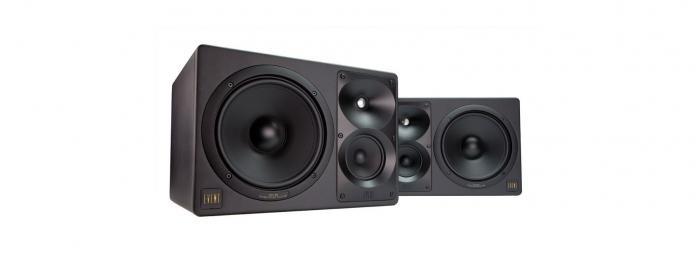Event Electronics has announced their first three-way monitoring system – Event Electronics 2030. The new studio monitors from Event are combining three discrete drivers for a very accurate reproduction of the entire audio spectrum.
“We’re incredibly excited about the 2030” said Event’s Global Sales & Marketing Manager, Damien Wilson. “Both the 20/20BAS and the Opal are truly legendary speakers, and now we are able to offer an accurate, detailed three-way system at a price that makes the 2030 the clear leader in its category”.
Rather than simply adding a mid-range driver to the Event 20/20 BAS configuration which could have been easily achieved, Event’s engineers took the three-way concept to a new level, resulting in a class-defining speaker system with compelling audio performance and a physical embodiment that makes it ideal for use in near field applications. A new wave guide assembly was designed to house the speaker’s mid-range and high frequency drivers as well as optimise audio dispersion and power response characteristics.
For the critical mid-range application a 3.5-inch cone transducer was engineered using a pressed pulp and polypropylene cone, combined with an optimised magnetic circuit. The driver is loaded onto a shallow wave guide that results in increased sensitivity and output while generating very low distortion artefacts, giving the 2030 speaker system an incredibly defined, upfront vocal character.
Combined with an aluminum alloy dome tweeter, the mid-high wave guide assembly employs an optimised set of electronic acoustic filters, derived from Event’s flagship Opal studio monitor, to maximise phase, time correction and frequency response characteristics. The resulting signal processing achieves controlled audio reproduction and smooth frequency response performance extending well above 20 kHz.
A key design feature of the 2030 amplifier is use of a proprietary, soft clipping power amplifier design topology that never allows the amplifier’s output waveform to become jagged or harsh. This results in a speaker system whose character stays consistent no matter what the output level, as audible distortion artefacts are kept under control. New Event 2030 Reference Monitoring System combines precisely engineered acoustic design, signal processing and amplifier technology to provide an incredibly detailed and wide soundstage with a bass response that far exceeds what most would expect from a box this size.
Event Electronics 2030 Reference Studio Monitors Technical Specs
System
# Type: Three-way, bass reflex
# Frequency Response: 38Hz – 22kHz
# Crossover Frequencies: 400Hz & 3kHz
# Crossover Type: Linkwitz-Riley Acoustic – Fourth order for Low/Mid range Event Proprietary Acoustic – Second order for Mid/High range
# Low Frequency Filter: Butterworth Subsonic Second Order (-3dB at 38Hz)
# Acoustic Output – SPL @ 1m, Long term (80Hz – 20kHz): 111dB
# Acoustic Output – SPL @ 1m, Peak (80Hz – 20kHz): 114dB
# Signal Input: XLR (balanced)
# AC Input Connector: 3-Pin IEC
# Average Long Term Power Consumption: 95 watts
# Quiescent Power Consumption <10 watts
# Overdrive Protection: Event proprietary IC based fast limiting with sliding gain
# Thermal Protection: Thermal cutoff switch, auto reset
Low Frequency Transducer
# Piston Diameter: 180mm (7.1″)
# Voice Coil Diameter: 38mm (1.5″)
# Former Material: Kapton
# Voice Coil Wire: Copper
# Magnet Type: Ferrite (fully shielded)
# Cone Type: Mineral Filled Polypropylene
Mid Range Transducer
# Piston Diameter: 85mm (3.3″)
# Voice Coil Diameter: 25mm (1″)
# Former Material: Glass Fiber
# Voice Coil Wire: Copper
# Magnet Type: Ferrite
# Cone Type: Pressed pulp/Mineral filled polypropylene
High Frequency Transducer
# Piston Diameter: 19mm (0.75″)
# Voice Coil Diameter: 19mm (0.75″)
# Magnet Type: Neodymium (fully shielded)
# Cone Type: Aluminium alloy with Ferrofluid cooled magnetic gap
Low Frequency Amplifier
# Frequency Response: 20Hz – 40kHz(±0.25dB) (bandwidth limited)
# Operating Band Pass: 20Hz – 400Hz
# Total Harmonic Distortion: 0.02% 120 Watts into 4 Ohm Load
# Long Term Power @ 4 Ohms: 80 Watts
# Power @ 4 Ohms: 120 Watts
# Output Topology: Class AB with proprietary soft clipping topology
# Cooling: Convection – Aluminum Heat Sink
High Frequency Amplifier
# Frequency Response: 20Hz – 40kHz(±0.25dB) (bandwidth limited)
# Operating Band Pass: 400Hz – 30kHz
# Total Harmonic Distortion: 0.02% 120 Watts into 4 Ohm Load
# Long Term Power @ 4 Ohms: 80 Watts
# Power @ 4 Ohms: 120 Watts
# Output Topology: Class AB with proprietary soft clipping topology
# Cooling: Convection – Aluminium Heat Sink
Physical
# Cabinet Construction: Engineered Composite Wood
# Low Frequency Vent: High “Q” / High Output Rear Firing Port
# Cabinet Volume: 16 Litres
# Cabinet Dimensions: 260mmW x 375mmH x 310mmD (10.2″W x 14.8″H x 11.8″D)
# Cabinet Weight: 14.6kg (32lb)
# Shipping Dimensions: 435mmW x 500mmH x 415mmD (17.1″W x 19.7″H x 16.3″D)
# Shipping Weight: 16.5kg (36lb)
# Operating Temperature Range: 5-35 deg C / 40-95 deg F
Power Supply
# Type: Torodial
# Rating: 270VA
# AC Mains fuse and AC voltage selector: 100V-120V 5 Amp / 220V-250V 2.5 Amp
The price for 2030 – Three Way Studio Monitors is not announced yet. More details you can find directly on the product page on the official site – EventElectronics.Com.


